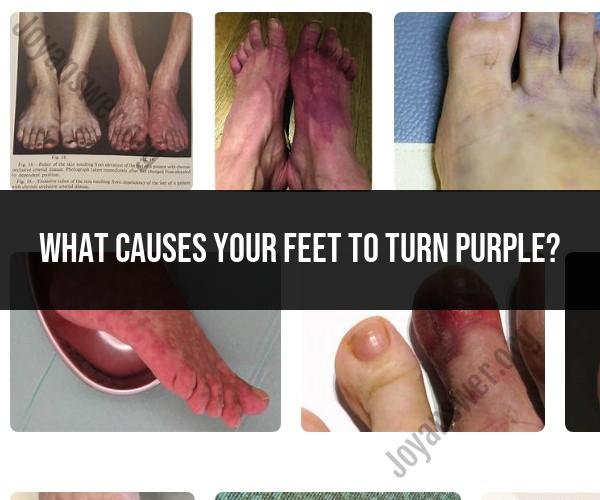What causes your feet to turn purple?
Purple discoloration of the feet can be a concerning symptom and may indicate an underlying health issue. There are several potential causes of purple feet, and it's essential to consult a healthcare professional for a proper diagnosis and appropriate treatment. Some common causes include:
Poor Circulation:
- Reduced blood flow to the feet can lead to skin discoloration. Peripheral artery disease (PAD), atherosclerosis, or other vascular problems can cause poor circulation. Diabetes can also contribute to circulation issues.
Raynaud's Disease:
- Raynaud's disease is a condition that causes blood vessels in the fingers and toes to constrict in response to cold temperatures or stress. This constriction can lead to a bluish or purple discoloration in the extremities.
Venous Insufficiency:
- Venous insufficiency occurs when the veins in the legs have difficulty returning blood to the heart. This can cause blood to pool in the lower extremities and may result in purple or discolored skin, particularly around the ankles.
Deep Vein Thrombosis (DVT):
- DVT is a blood clot that forms in a deep vein, most commonly in the legs. It can lead to restricted blood flow and skin discoloration, along with swelling and pain.
Peripheral Edema:
- Swelling of the feet and ankles, known as peripheral edema, can cause skin discoloration. Edema can result from heart conditions, kidney problems, or other underlying issues.
Infection or Inflammation:
- Infections or inflammation in the foot or lower leg can cause redness or purplish discoloration. Cellulitis or other skin infections are examples.
Medications:
- Some medications, especially those that affect blood flow or blood vessels, can cause skin discoloration as a side effect.
Cold Exposure:
- Exposure to extreme cold can cause the blood vessels in the feet to constrict, resulting in a temporary purplish appearance. Frostbite can also cause severe skin discoloration due to tissue damage.
Nerve Disorders:
- Some neurological disorders may impact blood vessel control, leading to circulation issues and skin discoloration.
Hematological Disorders:
- Certain blood disorders, such as thrombocytopenia or clotting disorders, can lead to purple or bruised-looking skin.
Chemical Exposure or Allergic Reactions:
- Contact with specific chemicals, toxins, or allergens can cause skin reactions and discoloration.
It's essential to seek prompt medical attention if you notice persistent or unexplained purple discoloration of your feet. A healthcare professional can perform a physical examination, order necessary tests, and determine the underlying cause. Treatment will depend on the diagnosis and may involve managing an underlying medical condition, addressing circulation issues, or addressing the specific cause of discoloration. Early intervention is crucial to prevent complications and ensure optimal foot health.
Understanding the Causes of Purple Feet: Insights and Concerns
Purple feet can be caused by a variety of factors, including:
- Reduced blood flow: This can be caused by conditions such as peripheral artery disease (PAD), Raynaud's disease, and diabetes.
- Cold temperatures: Exposure to cold temperatures can cause blood vessels to constrict, reducing blood flow to the feet.
- Injuries: Injuries to the feet can damage blood vessels and nerves, which can lead to purple feet.
- Medications: Certain medications, such as beta-blockers and ergotamines, can cause purple feet as a side effect.
- Medical conditions: Some medical conditions, such as frostbite, lupus, and scleroderma, can also cause purple feet.
Common Factors Contributing to Discolored Feet
The most common factor contributing to discolored feet is reduced blood flow. This can be caused by a variety of conditions, including peripheral artery disease (PAD), Raynaud's disease, and diabetes.
PAD is a condition in which the arteries that carry blood to the legs and feet become narrowed or blocked. This can reduce blood flow to the feet and cause them to turn purple.
Raynaud's disease is a condition in which the blood vessels in the fingers and toes constrict in response to cold temperatures or stress. This can cause the fingers and toes to turn white, blue, and then purple.
Diabetes is a condition in which the body does not produce enough insulin or does not use insulin properly. This can lead to high blood sugar levels, which can damage blood vessels and nerves. This can cause purple feet in people with diabetes.
Other common factors that can contribute to discolored feet include:
- Cold temperatures
- Injuries
- Medications
- Medical conditions such as frostbite, lupus, and scleroderma
When to Seek Medical Attention for Purple Feet
If you have purple feet that are accompanied by any of the following symptoms, you should seek medical attention immediately:
- Pain
- Numbness
- Tingling
- Coldness
- Sores
- Wounds
- Changes in skin color
If you have purple feet and any of these symptoms, it is possible that you have a serious medical condition that needs treatment.
Self-Care and Prevention Tips for Foot Health
There are a number of things you can do to take care of your feet and prevent purple feet, including:
- Keep your feet warm. Wear warm socks and shoes in cold weather.
- Avoid smoking. Smoking can damage blood vessels and make it more difficult for blood to reach your feet.
- Exercise regularly. Exercise helps to improve blood circulation.
- Eat a healthy diet. A healthy diet can help to keep your blood vessels healthy.
- Manage any underlying medical conditions. If you have a medical condition that can contribute to purple feet, such as PAD, Raynaud's disease, or diabetes, it is important to manage your condition carefully.
Personal Experiences and Advice on Dealing with Purple Feet
Here are a few personal experiences and advice on dealing with purple feet:
- John: "I have PAD and my feet often turn purple. I keep my feet warm by wearing warm socks and shoes. I also exercise regularly and eat a healthy diet. These things have helped to reduce the number of times I get purple feet."
- Jane: "I have Raynaud's disease and my feet often turn purple when I am cold or stressed. I avoid smoking and I manage my stress levels with exercise and relaxation techniques. I also keep my feet warm by wearing warm socks and shoes."
- David: "I have diabetes and my feet often turn purple. I manage my diabetes by taking medication and following a healthy diet. I also see a podiatrist regularly to check my feet for any problems."
If you have purple feet, it is important to talk to your doctor to determine the cause of your purple feet and get appropriate treatment.













